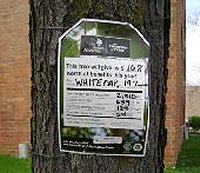AgEBB-MU CAFNR Extension
Green Horizons
Volume 21, Number 1
January 2017
Urban Forestry
Ten-year Urban Forestry Action Plan
By Jerry Van Sambeek | USDA Forest Service Center for Agroforestry
The Ten-year Urban Forestry Action Plan: 2016-2026 was published in September, 2015 (see http://www.urbanforestry.subr.edu/FinalActionPlan_Complete_11_17_15.pdf). This 260 page heavily illustrated document was prepared by the National Urban and Community Forestry Advisory Council (NUCFAC) under leadership and funding from the USDA Forest Service. The Plan's purpose is to expand awareness of the benefits urban forests provide to communities throughout the nation and increase investments in urban forest resources for the benefit of current and future generations.
The Plan's vision is to see "Urban and Community Forests Increase Sustainability, Wellness, and Resilience in All Communities". Its mission is to help all communities create urban and community forests that are diverse, healthy, and accessible for all citizens. The plan has seven goals: (1) integrate urban and community forestry into all scales of planning; (2) promote the role of urban and community forestry in human health and wellness; (3) cultivate diversity, equity, and leadership within the urban forestry community; (4) strengthen urban and community forest health and biodiversity for long-term resilience; (5) improve urban and community forest management, maintenance, and stewardship; (6) diversify, leverage, and increase funding for urban and community forestry; and (7) increase public awareness of environmental education to promote stewardship.
The Plan emphasizes that urban forests are the backbone of strong, vital, and healthy communities, enriching the lives of the more than 80 percent of Americans who live in cities and towns. There are an estimated 3.8 to 4 billion urban trees in the US. It reports urban trees are 15 times more effective than forest trees at reducing the buildup of carbon dioxide and promoting energy conservation by mitigating the urban heat island effect and reducing energy consumption. In 2010, Missouri had 2,054 square miles (6.9% of the total land base) of urban forests that are expected to rise to 4,743 square miles by 2050. Nationally, urban forest cover is 3.1% of the total land area and expected to rise to 8.1% by 2050.
Urban forests annually provide an estimated 17 billion dollars in ecosystem service benefits such as improved air quality, reduced heating and cooling costs, greater carbon sequestration, better storm water management, increased property values and improved mental and physical health.
 |
Figure 1. Signage in a Chicago park on a 19.7" diameter (dbh) white oak that provides $168 worth of benefits/yr. (i.e., reduces storm water runoff by 2,510 gals.; reduces carbon by 639 lbs.; creates electrical energy savings of 124 kWh; and increases property value by $54). |
The Plan can serve as a reference guide for those interested in the development and management of their urban and community forests. Most of the goals include 3 to 5 strategies followed by action items that can be used to monitor achievements. Some past successes include development of the i-Tree analytical software which helps communities identify and quantify benefits from their urban trees. Forest ReLeaf of Missouri is highlighted for development of a new tree plotting tool designed to track trees planted by volunteers throughout Missouri. In January 2016, Forest ReLeaf of Missouri, along with the Missouri Community Forestry Council, launched "Vision 20/20 - Plant 1 Million MOre Trees by 2020." Groups from throughout Missouri are being encouraged to plot locations, identify species and collect other details about their newly planted trees.
Project Learning Tree (PLT) has developed and distributed an array of environmental education packages to over 200,000 educators for PreK-12 students focused on trees and forests. From 2006-2016, copies of PLT's PreK-12 Environmental Education Activity Guide, PLT's Environmental Experiences for Early Childhood, and their high school modules, Focus on Forests and Places We Live, have been distributed to educators through in-person PLT workshops. PLT's grant program GreenWorks! has supported more than 520 service-learning projects specifically related to enhancing students' knowledge of trees through planting trees and gardens on school grounds and in communities.
During the last ten years, we have seen a 60% increase in urban forestry plans, a 53% increase in number of communities with professional forestry staff (the number in Missouri increased by more than 100%), and a 58% increase in the number of communities establishing policies and ordinances for managing urban trees. The current investment nationally is approximately 23 million dollars. Currently, for every dollar invested in tree management, benefits of $1.32 to $3.04 in ecosystem services are obtained. More than 7,000 communities receive urban and community forestry assistance. Increasing the annual investment to $85 million, as recommended in the plan, is an important first step towards unlocking its true value and one we all need to support.
